Related Research Articles

Zemun is a municipality in the city of Belgrade, Serbia. Zemun was a separate town that was absorbed into Belgrade in 1934. It lies on the right bank of the Danube river, upstream from downtown Belgrade. The development of New Belgrade in the late 20th century expanded the continuous urban area of Belgrade and merged it with Zemun.

New Belgrade is a municipality of the city of Belgrade. It was a planned city and now is the central business district of Serbia and South East Europe. Construction began in 1948 in a previously uninhabited area on the left bank of the Sava river, opposite old Belgrade. In recent years, it has become the central business district of Belgrade and its fastest developing area, with many businesses moving to the new part of the city, due to more modern infrastructure and larger available space. With 209,763 inhabitants, it is the second most populous municipality of Serbia after Novi Sad.
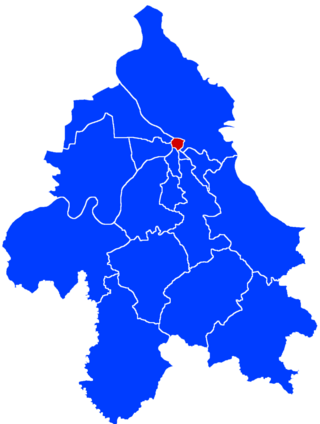
Stari Grad is a municipality of the city of Belgrade. It encompasses some of the oldest sections of urban Belgrade, thus the name. Stari Grad is one of the three municipalities that occupy the very center of Belgrade, together with Savski Venac and Vračar.
Donji Grad is an urban neighborhood of Belgrade, the capital of Serbia. It is located in Belgrade's municipality of Zemun.
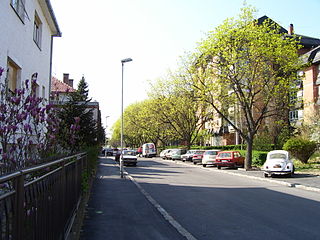
Galenika or Nova Galenika is an urban neighborhood of Belgrade, the capital of Serbia. It is located in Belgrade's municipality of Zemun.
Gornji Grad is an urban neighborhood of Belgrade, the capital of Serbia. It is located in Belgrade's municipality of Zemun.

Kalvarija, also formerly known as Marija Bursać is an urban neighborhood of Belgrade, the capital of Serbia. It is located in Belgrade's municipality of Zemun.
Kolonija "B" Zmaj or colloquially Zmaj is an urban neighborhood of Belgrade, the capital of Serbia. It is located in Belgrade's municipality of Zemun.
Novi Grad is an urban neighborhood of Belgrade, the capital of Serbia. It is located in Belgrade's municipality of Zemun.
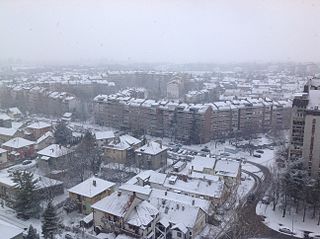
Sutjeska is an urban neighborhood of Belgrade, the capital of Serbia. It is located in Belgrade's municipality of Zemun.

Blokovi or Novobeogradski blokovi is the semi-formal plural name for a group of urban neighborhoods in Belgrade's municipality of New Belgrade.

Busije is a suburban neighborhood of Belgrade, the capital of Serbia. It is located in Belgrade's municipality of Zemun.

Zeleni Venac or colloquially Zelenjak is an urban neighborhood of Belgrade, the capital of Serbia. It is located in the Belgrade's municipalities of Savski Venac and Stari Grad.

Ćukovac is an urban neighborhood of Belgrade, the capital of Serbia. It is located in Belgrade's municipality of Zemun.

Branko's Bridge is the second-largest bridge of Belgrade, Serbia, connecting the city center with New Belgrade across the Sava river. Built in 1956 on the foundations of the 1934 King Alexander Bridge, which was destroyed in World War II, it reconnected Belgrade and Zemun as the only motorway bridge at the time. After several official and unofficial names, the present name stuck after the Brankova Street, which extends into the bridge from the direction of the old section of Belgrade.

Gardoš is an urban neighborhood of Belgrade, the capital of Serbia. It is located in Belgrade's municipality of Zemun. Located on the slopes of the hill of the same name, with its tower and preserved old architecture, Gardoš is the major historical landmark of Zemun. Remnants of the Gardoš Fortress, built in the 14th century and the 15th century, are the oldest surviving parts of Zemun.

Sava Kovačević is an urban neighborhood of Belgrade, Serbia. It is located in Belgrade's municipality of Zemun.
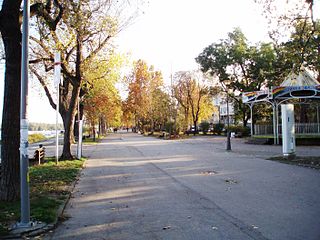
Zemunski Kej is an urban neighborhood of Belgrade, the capital of Serbia. It is located in Belgrade's municipality of Zemun.

The Gardoš Tower, also known as Millennium Tower or Kula Sibinjanin Janka is a memorial tower located in Zemun, city of Belgrade, Serbia. It was built and officially opened on 20 August 1896 to celebrate a thousand years of Hungarian settlement in the Pannonian plain. The Millennium project included seven monuments in total all over the Hungarian part of Austro-Hungary, with Gardoš Tower being the southernmost; the others were at Budapest, Brassó, Dévény, Munkács, Nyitra, and Szeged. They were all different, including obelisks and columns.
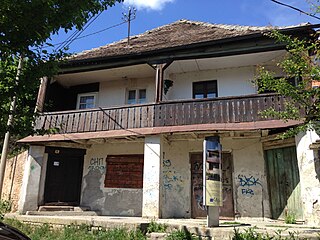
White Bear Tavern is a former kafana in Belgrade, in the municipality of Zemun. First mentioned in 1658, it is the oldest surviving edifice in the territory of modern Belgrade, not counting the Belgrade Fortress. However, Zemun developed completely independently from Belgrade for centuries and for the most part during the history two towns belonged to two different states. Zemun became part of the same administrative unit as Belgrade on 4 October 1929, lost a separate town status to Belgrade in 1934 and made a continuous built-up area with Belgrade only since the 1950s. Hence, the House at 10 Cara Dušana Street in Belgrade's downtown neighborhood of Dorćol is usually named as the oldest house in Belgrade, while the White Bear Tavern is titled as the oldest house in Zemun. In 2023, it was declared a cultural monument.
References
This article needs additional citations for verification .(May 2008) |
44°50′43″N20°24′30″E / 44.84528°N 20.40833°E